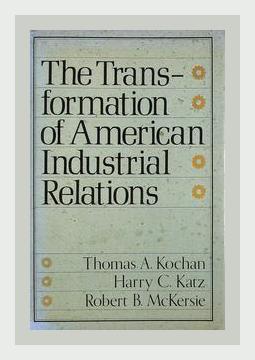Human Resources and Talent ManagementLabor Relations
**
Introduction
“The Transformation of American Industrial Relations” provides a comprehensive analysis of how labor relations in the United States evolved during the late 20th century. The authors, Thomas A. Kochan, Harry C. Katz, and Robert B. McKersie, delve into the factors that led to significant changes and propose strategies for improving labor relations moving forward. Their comprehensive study includes a mix of historical context, examples from various industries, and data analysis. Below is a structured summary of the main points and actionable advice from the book.
1. Historical Context and Evolution
The book begins by outlining the history of American industrial relations, emphasizing the post-World War II period when labor unions gained substantial power. However, by the 1980s and 1990s, the landscape began to shift due to economic globalization, technological advancements, and changing management strategies. The decline in union membership and the rise of more flexible labor practices marked this era.
Actionable Advice: Understand historical trends in labor relations to foresee potential shifts. Modern managers should stay informed about macroeconomic trends and their impact on employee relations.
2. Decline of Union Influence
A significant portion of the book is dedicated to examining the declining influence of unions. The authors highlight that factors such as increased global competition, shifts towards service-oriented industries, and changes in labor laws contributed to this decline.
Example: The authors cite the automotive industry, where competition from foreign manufacturers pressured American automakers to reduce costs and workforce size, thereby weakening unions.
Actionable Advice: Adapt negotiation strategies to the current landscape. For union leaders, this means seeking novel ways to provide value to members. For managers, it means engaging in fair and just negotiations to maintain a positive workplace environment.
3. Technological and Organizational Changes
The advent of new technologies has significantly altered the nature of work and labor relations. Automation, information technology, and the rise of the gig economy have changed organizational structures and employment practices.
Example: The introduction of robotics in manufacturing sectors reduced the demand for unskilled labor but increased the need for technically skilled workers.
Actionable Advice: Invest in employee training and development to ensure they can adapt to new technologies. This effort should be a collaborative endeavor between management and labor organizations to promote job security and organizational efficiency.
4. Innovative Labor Management Practices
The book discusses various case studies where organizations have successfully implemented innovative labor management practices. One noteworthy example is the collaborative approach adopted by Saturn Corporation, a subsidiary of General Motors. Saturn focused on joint decision-making, team-based problem-solving, and continuous improvement.
Actionable Advice: Foster collaborative labor relations by establishing joint committees for decision-making and problem-solving. This can enhance trust and innovation within the organization.
5. Employee Participation and Involvement
Employee participation is presented as a vital aspect of modern industrial relations. The authors argue that involving employees in decision-making processes improves morale, productivity, and job satisfaction.
Example: The case of Xerox Corporation is used to illustrate how employee involvement in quality improvement teams led to significant enhancements in product quality and operational efficiency.
Actionable Advice: Implement participatory mechanisms like quality circles or employee advisory boards. Encourage regular feedback and suggestions from employees on operational improvements.
6. Legal and Policy Framework
The book underscores the importance of the legal and policy framework governing labor relations. Changes in labor laws, such as the Taft-Hartley Act, have had profound impacts. The authors discuss the necessity for reforms to adapt to the evolving labor landscape.
Actionable Advice: Stay informed about current laws and potential legal changes. Labor leaders should advocate for policies that protect workers’ rights and support fair labor practices, while managers should ensure compliance and adapt their practices accordingly.
7. Strategic Unionism
The authors propose the concept of strategic unionism, shifting the role of unions from a reactive stance to a proactive strategy in addressing the needs of the modern workforce. This involves focusing on long-term goals rather than immediate gains.
Example: The Service Employees International Union (SEIU) is highlighted for its strategic approach, including organizing campaigns that focus on long-term sectoral gains.
Actionable Advice: Union leaders should develop strategic plans that address future industry trends and workforce needs. This may include partnerships with other organizations and stakeholders to advance larger objectives.
8. The Role of Human Resource Management (HRM)
HRM practices have evolved in response to changes in industrial relations. The shift from adversarial relations to more collaborative ones has enhanced the role of HR in mediating and fostering positive labor relations.
Example: The book references IBM’s HR policies, which emphasize employee development and open communication channels between management and employees.
Actionable Advice: HR managers should focus on creating a supportive work environment through transparent communication, continuous employee development, and fostering a culture of inclusivity.
9. Cultural and Structural Adaptations
The authors discuss how cultural and structural changes within organizations can support better labor relations. Creating a culture of mutual respect and trust is crucial for organizational success.
Example: The airline industry’s shift towards more cooperative labor relations models, with Southwest Airlines being a prime example, is highlighted.
Actionable Advice: Promote a culture of respect and inclusion. Encourage behaviors that foster mutual trust and understanding between employees and management.
10. Future Directions for Industrial Relations
Finally, the book reflects on future directions for industrial relations, emphasizing the need for adaptability, continuous learning, and proactive engagement from both labor and management.
Actionable Advice: Both unions and management should invest in research and development to stay ahead of trends. Engage in continuous dialogue to address emerging challenges collaboratively.
Conclusion
“The Transformation of American Industrial Relations” offers a thorough examination of the changes in labor relations over the late 20th century. By analyzing historical trends, technological impacts, and innovative labor practices, the authors provide valuable insights for both labor leaders and management. Emphasizing collaboration, employee involvement, strategic planning, and adaptability, the book offers practical actions that can be taken to foster positive and productive labor relations in a changing world.
